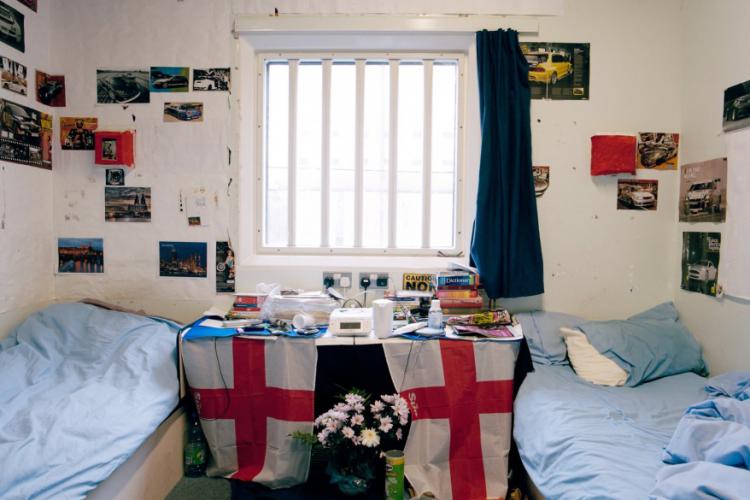Guest post by Sarah Hughes, a second-year PhD student based in Durham University’s Department of Geography. Her research brings into conversation literatures on creativity with debates on resistance within the interstitial spaces of the UK asylum system. Follow Sarah on Twitter @Sarah_Hughes90.
On 23 May 2016, I attended the ‘Border Control’ workshop held at the Ruskin School of Art in Oxford, part of Mary Bosworth’s ERC-funded ‘Subjectivity, Identity and Penal Power’ project. I attended the event as neither a criminologist nor an artist, but as a geographer who’s currently writing about creativity within the UK’s asylum system. Dr Sarah Turnbull has already provided an excellent summary of the day’s stimulating presentations and lively conversation on this blog. In addition to this, I provide here a brief reflection on the workshop, discussing how the talks, conversations, and artwork presented interesting provocations for the potential of art to open up new spaces for articulating and understanding incarceration.
At the start of the workshop, Dr Khadija von Zinnenburg Carroll showed the beginnings of a film that she’s currently working on. It’s comprised of detainees’ artwork, testimonies, and photographs, including a man who walks in circles around a courtyard. The disjointed, non-linear experience of time within British immigration removal centres (IRCs) has been explored previously (see work by Sarah Turnbull, Mary Bosworth, and Melanie Griffiths), yet, when represented in this particular form, this topic was able to take on new (and for me, emotive) affects. Round and round the man walked, the repetition of his movements unable to be represented through my writing. The audience could see his face, his movement, and his humanity in visual form. As such, this representation of experiences of time through film has the potential to open up novel discussions, audiences, and responses to incarceration. Throughout the workshop, the folding of the conceptual into the material forms of artwork revealed multiple exciting possibilities for the creation of new platforms upon and through which interdisciplinary conversations around immigration detention could take place.

Another clear example of the resonances between artwork and academic research can be seen in ‘No Man’s Land,’ a series of pieces created by Nana Varveropoulou. Throughout the day’s introduction, Nana’s projected images from inside Colnbrook IRC formed a silent visual backdrop to Mary Bosworth’s opening talk; the description and explanation of the detention system in the UK was framed by photos of decorated bedrooms, of detainees, of an unfinished game of dominos on a table. The liveliness of these visual images extended beyond their content; their intensity pressed upon the audience and they resonated with Mary’s commentary, giving affective force to her explanations.
Interesting discussion also arose later in the day between Edmund Clark, Mario Badagliacca, and Khadija around the governance of circulation of artwork, concerning those pieces created by immigration detainees, and those artworks responding to incarceration. This part of the day resonated most clearly with my own PhD research which explores how Home Office and IRC staff become enrolled into a logic of paranoia: a hypersensitivity to the unwanted circulation of videos and images, which could be documenting abuse or creative practices showing detainees apparently enjoying themselves. As one art practitioner explained to me in an interview, ‘there’s always a Sun or Daily Mail headline waiting to happen you know, so you’re kind of meant to do a good job, but don’t draw too much attention to doing a very good job… Then you start bumping into bits of resistance because people don’t necessarily want the Daily Mail to be going ‘look what they’re spending their money on’ (see also this new book by Nick Gill). Yet, as the examples from Khadija and Nana reveal, certain artwork does circulate: the materials displayed at the workshop have a freedom that’s not afforded to their creators; they can remain in the country and circulate beyond the walls of carceral spaces.
It was therefore fascinating to hear from Edmund about his work as an artist in residence at HMP Grendon, including the realities of working with prisoners and the circulation of art within the context of incarceration. This opened up to wider conversations around the legalities, practicalities, and emotions of working within sites of incarceration, with Edmund, Khadija, and Mario explaining their experiences and the implications of these for circulating their artwork. The workshop discussion reflected upon the inability of the artist or the state to fully govern or control the impact of artwork. However as Khadija articulated, attention to the production and circulation of artwork within carceral spaces isn’t to view it as a therapeutic and redemptive practice, and neither should a focus upon its potential affects negate the unequal relations of power in which its creation takes place. Instead, the discussions at the workshop explored what an attention to these material traces of life inside detention centres can bring to developing new vocabularies for current practice: What can a consideration to the circulation of artwork bring to a system premised upon categorising people to control their movement? The workshop therefore provided a valuable platform for such discussions around the intersection of border control and art, engaging with the politics of the creation, governance, and circulation of artwork created in, and around, sites of incarceration.
Any comments about this post? Get in touch with us! Send us an email, or post a comment here or on Facebook. You can also tweet us.
__________
How to cite this blog post (Harvard style):
Hughes, S. (2016) Border Control: Reflections on Artwork in Spaces of Incarceration. Available at: https://www.law.ox.ac.uk/research-subject-groups/centre-criminology/centreborder-criminologies/blog/2016/06/border-control (Accessed [date]).
Share:








